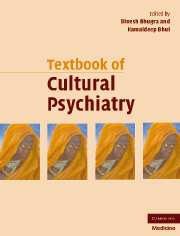Book contents
- Frontmatter
- Contents
- Contributors
- Foreword
- Preface
- Part I Theoretical background
- Part II Culture and mental health
- 8 Culture and psychopathology: general view
- 9 Developmental aspects of cultural psychiatry
- 10 Explanatory models in psychiatry
- 11 Culture-bound syndromes: a re-evaluation
- 12 Psychiatric epidemiology and its contributions to cultural psychiatry
- 13 Acculturation and identity
- 14 Cultural consonance
- Part III Culture and mental disorders
- Part IV Theoretical aspects of management
- Part V Management with special groups
- Part VI Cultural research and training
- Cultural psychiatry: the past and the future
- Index
- References
12 - Psychiatric epidemiology and its contributions to cultural psychiatry
from Part II - Culture and mental health
Published online by Cambridge University Press: 11 August 2009
- Frontmatter
- Contents
- Contributors
- Foreword
- Preface
- Part I Theoretical background
- Part II Culture and mental health
- 8 Culture and psychopathology: general view
- 9 Developmental aspects of cultural psychiatry
- 10 Explanatory models in psychiatry
- 11 Culture-bound syndromes: a re-evaluation
- 12 Psychiatric epidemiology and its contributions to cultural psychiatry
- 13 Acculturation and identity
- 14 Cultural consonance
- Part III Culture and mental disorders
- Part IV Theoretical aspects of management
- Part V Management with special groups
- Part VI Cultural research and training
- Cultural psychiatry: the past and the future
- Index
- References
Summary
EDITORS' INTRODUCTION
The relationship between cultural psychiatry and psychiatric epidemiology is of constructive tension. Although in certain fields of cultural psychiatry epidemiology studies are problematic because of small numbers, the basic premise of epidemiology can be employed provided the interpretation of the findings is clearly contextualized. The measurement of psychopathology across cultures using the same set of tools is fraught with major difficulties. The category fallacy under these circumstances raises critical questions. It is also of interest that often these assessment tools move from Euro-US centric settings to the rest of the world, rather than the other way around.
Kohn and Bhui examine the contribution of psychiatric epidemiology to cultural psychiatry, and some controversial questions. They argue that psychiatric epidemiology has evolved since the study by Jarvis in 1855 in which higher rates of mental illness were found among the Irish immigrants in the pauper classes in Massachusetts, USA. Since then, psychiatric epidemiology has undergone at least three generations of evolution, followed most recently by the fourth stage from which cultural epidemiology has emerged as the a new branch of epidemiology, taking in perspectives from medical anthropology, epidemiology and public health. The implications of these changes are tremendous, both for clinicians and researchers.
Introduction
The methodological advances of psychiatric epidemiology revealed the limitations of earlier psychiatric research. These critiques had implications for the use of diagnostic instruments, and for the methodological advances needed to study cultures and compare mental-health problems in diverse cultural groups.
- Type
- Chapter
- Information
- Textbook of Cultural Psychiatry , pp. 157 - 168Publisher: Cambridge University PressPrint publication year: 2007
References
- 2
- Cited by



